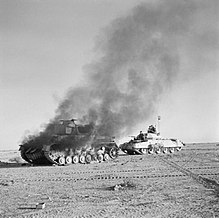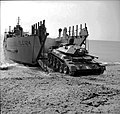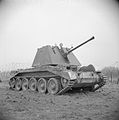Crusader (tank)
| Cruiser Tank Mk VI | |
|---|---|

Crusader II in Africa 1942 |
|
| General properties | |
| crew | 4 (commander, driver, gunner, loader) |
| length | 5.97 m |
| width | 2.77 m |
| height | 2.24 m |
| Dimensions | 19.3 t |
| Armor and armament | |
| Armor | 7-40 mm |
| Main armament | 1 × 2-pounder Mk. I 40 mm |
| Secondary armament | 2 × MG Besa 7.92 mm |
| agility | |
| drive | Nuffield "Liberty" Mk. III , 12-cylinder V-engine 340 HP (250KW) |
| Top speed | 43 km / h |
| Power / weight | 13.0 kW / t (17.6 PS / t) |
| Range | 322 km |
Cruiser Tank Mk VI or Crusader (English for crusaders ) was the name of a British tank that was mainly used in the North African theater of war during World War II .
Development and production
development
The impetus for the development of a number of British tanks, later known as cruiser tanks , came from a visit to the USSR by British Lieutenant Colonel Wavell in 1937 . There, the mobility of the BT series impressed the delegation members so much that in Great Britain he enforced the license purchase of the construction by the American John Walter Christie , on which the Soviet BT series was based. The General Staff of the United Kingdom formulated the requirements of the A13 tank with these impressions . The Nuffield organization instead developed an A16, which was too expensive, so the A13 concept was mixed with A16 components and the A13 Mk III was finally designed under the name Covenanter . Nullfield was supposed to build the Covenanter in his factory, but it was found that the A 13 Mk II version was easier to build with the existing means of production and a new proposal based on the Liberty engine was developed - the A15.
Nuffield's Liberty engine with twelve cylinders was chosen as the drive. The types Mk III, Mk III a and b and Mk IV of the engine were installed, which differed mainly in different concepts for the engine cooling, as the version Mk III later proved to be inadequate when used in the desert. The engines all developed around 340 hp (254 kW) at 1500 revolutions per minute.
Production and problems
In the summer of 1939, 100 prototypes were ordered from Mechanizations & Aero , which were delivered in April 1940. The first 200 series models were finished in early 1941. The first Mk I Crusaders were delivered to the units in May 1941. The Mk II and Mk III models were delivered in the course of 1942.
Eight companies were brought together in a consortium at peak times to build the Crusader . They produced about 110 vehicles a month at a cost of around £ 13,700 each. Mechanizations & Aero was the consortium leader, West's Gas Improvement Co. Ltd. and Foden produced complete vehicles, Milner's Safe Co. Ltd. , John Lysaght and Co. , Ruston-Bucyrus , Morris Commercial Cars and MG Car Co. were among the suppliers.
However, the production consortium was not always able to meet the required quantities. In 1942, for example, there were supply bottlenecks for armor plates and gearboxes. Furthermore, there were significant quality deficiencies in the Crusaders who reached the North African theater of war: The arms of the wheel suspensions broke, for example, with entire tank deliveries and had to be replaced on site, nuts were not properly tightened, so that around 200 hours of work per tank were required around the vehicles to make it operational at all. The range a Crusader could travel before the engine or transmission failed was 400 miles , making the 1942 model the Army's most unreliable tank. The best vehicle was the Valentine with a range of almost 950 miles.
According to the maintenance staff, the main problem was the origin of the Liberty engine, which had been developed for aircraft from the First World War and therefore did not have a cooling system that was suitable for a tank, especially in the desert. The factory-installed emergency cooling system consisting of fans and a water pump, which were driven directly by the crankshaft with a kind of bicycle chain , turned out to be devastating. The chain wore out through sand until it started to jump and damaged the sprocket on the crankshaft, which made it necessary to replace it in a three-day operation. The water cooling pump itself was poorly designed and quickly leaked.
Despite measures to improve quality, 30 of 41 vehicles examined in February 1943 still had a considerable need for repairs in order to be able to make them operational at all.
With the end of the African War, the Crusader was finally declared obsolete and retired. The units received new tank models, such as the M4 Sherman . A total of around 5,000 tanks of all types of the Crusader were built.
Calls
In 1941, Crusader were sent to Egypt and participated in Operation Battleaxe and Operation Crusader . The losses were high and the tank was not popular with its crews because of the technical problems, although it was basically a match for the German tanks. However, due to being armed with a 40 mm cannon and the associated lack of HE shells, he lacked the ability to effectively fight German anti-tank cannons. Due to its own weak armor, the Crusader was almost defenseless against German anti-tank weapons. The Crusader was a very effective weapon against the inferior Italian tanks M11 / 39 and M13 / 40 .
Technical data and variants
Crusader I
The A15 Mark I or Crusader I or Cruiser Mk. VI was the first type of Crusader to be used on the battlefield. It was equipped with a 40 mm cannon (2 pounder MK. II) and a coaxial Besa MG. In the front there was another small and poorly ventilated turret (similar to the side turrets of the early Vickerspanzer), which was equipped with a Besa machine gun (7.92 mm) and a light machine gun (7.69 mm). The tower was often dismantled in the Mk.-I version and replaced by an access hatch. 291 pieces were built.
- Crusader Mk. I CS , the Crusader I CS ( C lose S upport / Nahunterstützung) had a 3 ″ (76.2 mm) howitzer instead of the “2 pounder”.
Crusader II
The A15 Mark II or Crusader II or Cruiser Mk. VIA was outwardly quite similar to the Crusader I , but had a number of modifications. The most important changes were the new engine (more reliable) as well as the reinforced armor and the waiver of the side turret. The ammunition supply was also increased from 110 to 130 rounds, but this meant that the space for the crew was even smaller. 2312 vehicles of the type were produced.
- Crusader Mk. II CS , as with the Crusader I CS , the 2-pounder has been replaced by a 3 ″ (76.2 mm) howitzer.
- Crusader Mk. II OP , the command tank ( O bservation P ost) was a modification, which was equipped with two-19 No. radios and a dummy gun of wood. The omission of the cannon created the space for the necessary radios.
- Crusader Gun Tractor , was a special version that was built on the basis of the Crusader II chassis to form a tractor that pulls a 76.2 mm gun - the so-called 17 pounder - as well as the entire ammunition and eight men crew could record.
Crusader III
The A15 Mark III or Crusader III was the last version of the Crusader to be used as a main battle tank. A new turret design made it possible to install a 6 pounder (2.2 ″) 57 mm cannon. The armor was also reinforced. As a result, he could finally become dangerous to the German tanks III J and IV F2. Some were also equipped with a MG Vickers type "K" .303 (7.7 mm).
2362 vehicles of the type were produced.
- Crusader Mk. III OP , the command tank was a modification that was equipped with two No. 19 radios, one No. 18 radio and a wooden dummy gun.
- Crusader III AA Mk. I , an anti-aircraft tank with a 40 mm Bofors gun (autoloader) in an open top turret. Four men crew.
- Crusader III AA Mk. II / III , an anti-aircraft tank with a 20 mm Oerlikon cannon in a double mount. A few copies were produced with a triple carriage.
| Parameter | Data Mk I | different data Mk III |
|---|---|---|
| producer | Nuffield Mechanizations & Aero | |
| Weight | 19.3 t | 22.12 t |
| crew | 5 (4 without side tower) | 3 |
| Armament | ||
| Main tower | 2-pounder Mk. I 40 mm | 6 pounder 57 mm |
| 1 × MG Besa 7.92 mm (axially parallel) | ||
| Side tower | 1 × MG Besa 7.92 mm | no side tower |
| 1 × MG 7.69 mm with 600 rounds | no side tower | |
| engine | Nuffield "Liberty" Mk. III | "Liberty" Mk. IV |
| Displacement | V12; 27 liters | |
| Power to weight ratio | 16 hp / ton | 15.37 hp / ton |
| Propulsion system | Back | |
| fuel | petrol | |
| Corridors | four forward gears / one reverse gear | |
| Top speed | 43 km / h (road) / 24 km / h (terrain) | |
| Fuel supply | 500 liters (additional tank was standard on the Mk. I and Mk. II) | |
| Fuel consumption | on 100 km of road: 155 liters | |
| Range | 322 km | |
| Armor hull | 2 layers riveted | |
| Armor turret | 2 layers riveted | 1 layer welded |
| Armor, strength | up to 40 mm | up to 51 mm |
| Dimensions | ||
| length | 5.97 m | |
| width | 2.77 m | |
| height | 2.24 m | |
| Width of the chains | 257 mm | |
| Fording depth | 1 m | |
| Climbing ability | 0.69 m | |
| Trench overcoming up | 2.6 m | |
| Ground clearance | 41 cm | |
| Ground pressure | 1.06 kg / cm² | |
| introduction | 1940 | 1942 |
Preserved copies
- Crusader Mk. I, Royal Australian Armored Corps Museum , Puckapunyal
- Crusader Mk. II, South African Museum of Military History, Johannesburg
- Crusader Mk. III, Bovington Tank Museum
- Crusader Mk. III AA Mk. III, Musée des Blindés , Saumur
- Crusader Mk. III Gun Tractor Mk. I, Nationaal Oorlogs- en Verzetsmuseum , Overloon
Crusader III in Tunisia 1943, cleaning the 6 pounder cannon
Web links
literature
- David Fletcher: Crusader and Covenanter Cruiser Tanks 1939–45. Osprey Publishing, 1995, ISBN 1-85532-512-8 .
- Benjamin Coombs: British Tank Production and the War Economy, 1934-1945. Bloomsbury Academic, 2015, ISBN 978-1-4742-2790-2 .
Individual evidence
- ↑ David Fletcher: Crusader and Covenanter Cruiser Tanks 1939-45. Osprey Publishing, 1995, ISBN 1-85532-512-8 , p. 3.
- ^ Robert J. Neal: Liberty Engine: A Technical & Operational History. Specialty Press, 2008, ISBN 978-1-58007-149-9 , p. 421.
- ^ Robert J. Neal: Liberty Engine: A Technical & Operational History. Specialty Press, 2008, ISBN 978-1-58007-149-9 , pp. 422, 424 and following.
- ^ Robert J. Neal: Liberty Engine: A Technical & Operational History. Specialty Press, 2008, ISBN 978-1-58007-149-9 , p. 421.
- ^ Robert J. Neal: Liberty Engine: A Technical & Operational History. Specialty Press, 2008, ISBN 978-1-58007-149-9 , p. 424.
- ↑ After Robert J. Neal: Liberty Engine: A Technical & Operational History. Specialty Press, 2008, ISBN 978-1-58007-149-9 , p. 482 - in Benjamin Coombs: British Tank Production and the War Economy, 1934-1945. The Wolseley Motor Company is listed, which had already gone bankrupt in 1926. However, former Wolseley factories were used by Nuffield to produce the Liberty engine ( Liberty Engine: A Technical & Operational History, p. 415)
- ^ A b Benjamin Coombs: British Tank Production and the War Economy, 1934-1945. Bloomsbury Academic, 2015, ISBN 978-1-4742-2790-2 , Chapter 5 "Overcoming Production Problems and Delays"
- ↑ Steven Zaloga: Armored Champion: The Top Tanks of World War II Stackpole Books, ISBN 978-0-8117-1437-2 , pp. 154, 155
- ^ The Tank Museum: Tank Spotter's Guide. Osprey Publishing, 2011, ISBN 978-1-78096-052-4 , p. 33.
- ^ A b c Robert J. Neal: Liberty Engine: A Technical & Operational History. Specialty Press, 2008, ISBN 978-1-58007-149-9 , p. 484.
- ^ Robert J. Neal: Liberty Engine: A Technical & Operational History. Specialty Press, 2008, ISBN 978-1-58007-149-9 , p. 484.








